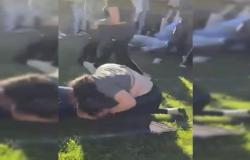Through visual and historical elements, photographs and legends, the newly inaugurated exhibition tells the story of Laurence Niyonangira, who fled the murders in his community, led by former neighbors.
With a narrative born of personal images, the common thread describes from the concept to the horrors of the genocide and the lasting legacy of its trauma.
The exhibition is an invitation to visitors to UN Headquarters in New York to confront the realities of hate speech and the critical role each individual plays in fostering a culture of tolerance and understanding.
“As survivors, we can only heal our wounds with the people who created them,” Laurence warns in one of the posters in the middle of the reconciliation process with one of the murderers of his mother and sister.
According to her story, the protagonist of the exhibition lost 37 members of her family during the genocidal acts.
The exhibition will remain accessible to the public until May 1 as a reminder of the attempted extermination of the Tutsi population by the hegemonic Hutu government of Rwanda.
That dark page of history ended with the murder of 70 percent of that population between April 7 and July 15, 1994.
It is estimated that between 500,000 and one million people were murdered while sexual violence became widespread and affected more than 250,000 women.
The mass murders began after the attack on April 6, 1994 against Rwandan President Juvénal Habyarimana and Burundian President Cyprien Ntaryamira, both Hutu, who died after the plane in which they were traveling was shot down by two missiles launched from the ground.
jha/ebr





